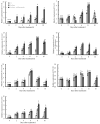Effects of Thifluzamide Treatment on the Production of Cell Wall Degrading Enzymes in Rhizoctonia solani and Phenylpropane Metabolism in Pear Fruit
- PMID: 39599516
- PMCID: PMC11597378
- DOI: 10.3390/pathogens13110963
Effects of Thifluzamide Treatment on the Production of Cell Wall Degrading Enzymes in Rhizoctonia solani and Phenylpropane Metabolism in Pear Fruit
Abstract
The study aimed to investigate the effects of thifluzamide (2.67 mg/L) on 'Huangguan' pear fruit rot caused by Rhizoctonia solani during storage, as well as the activities of polygalacturonase (PG), pectin methylesterase (PME), polygalacturonic acid trans-eliminase (PGTE), pectin methyl trans-eliminase (PMTE), xylanase, and pectate lyase (PL) secreted by R. solani. The results showed that thifluzamide treatment significantly inhibited the activities of PG, PME, PGTE, PMTE, xylanase, and PL secreted by R. solani after 3 days in vitro culture, compared to the control. Thifluzamide also increased the activities of phenylalanine ammonia-lyase (PAL), cinnamate-4-hydroxylase (C4H), and 4-coumarate CoA ligase (4CL), and the contents of flavonoids and total phenolic compounds in pear fruit. Furthermore, thifluzamide increased the expression of PcPAL, PcC4H, Pc4CL, Pcβ-1,3-GA, PcLCH, PcF3H, and PcDFR involved in phenylpropanoid metabolism in pear fruit. In conclusion, thifluzamide treatment reduced the infection ability of R. solani by inhibiting the expression of the genes encoding cell wall-degrading enzymes in R. solani. At the same time, it inhibited the activities of cell wall-degrading enzymes induced resistance against R. solani infection in 'Huangguan' pears by promoting phenylpropane metabolism.
Keywords: Rhizoctonia solani; cell wall-degrading enzyme; pear fruit; phenylpropanoid pathway; thifluzamide.
Conflict of interest statement
The authors declare that there are no conflicts of interest.
Figures






Similar articles
-
Acibenzolar-S-methyl activates calcium signalling to mediate lignin synthesis in the exocarp of Docteur Jules Guyot pears.Plant Physiol Biochem. 2022 Nov 1;190:174-183. doi: 10.1016/j.plaphy.2022.09.001. Epub 2022 Sep 7. Plant Physiol Biochem. 2022. PMID: 36116226
-
Exogenous p-coumaric acid treatment improves phenolic compounds biosynthesis of postharvest cherry tomatoes by regulating physiological metabolism.J Food Sci. 2024 Nov;89(11):7309-7323. doi: 10.1111/1750-3841.17408. Epub 2024 Sep 27. J Food Sci. 2024. PMID: 39331417
-
Fulvic acid-induced disease resistance to Botrytis cinerea in table grapes may be mediated by regulating phenylpropanoid metabolism.Food Chem. 2019 Jul 15;286:226-233. doi: 10.1016/j.foodchem.2019.02.015. Epub 2019 Feb 12. Food Chem. 2019. PMID: 30827600
-
Genome-wide characterization of PAL, C4H, and 4CL genes regulating the phenylpropanoid pathway in Vanilla planifolia.Sci Rep. 2025 Mar 28;15(1):10714. doi: 10.1038/s41598-024-81968-w. Sci Rep. 2025. PMID: 40155638 Free PMC article.
-
Changes and subcellular localizations of the enzymes involved in phenylpropanoid metabolism during grape berry development.J Plant Physiol. 2006 Feb;163(2):115-27. doi: 10.1016/j.jplph.2005.07.006. Epub 2005 Sep 9. J Plant Physiol. 2006. PMID: 16399002
References
-
- Joyce Garden. 2022. [(accessed on 19 December 2022)]. Available online: https://www.garden.eco/where-do-pears-grow.
-
- Warmly J. Northern Nester. 2022. [(accessed on 19 December 2022)]. Available online: https://northernnester.com/types-of-pears.
-
- Tomasz C., Jan O., Ireneusz K., Sabina L. Effect of abiotic stress factors on polyphenolic content in the skin and flesh of pear by UPLC-PDA-Q/TOF-MS. Eur. Food Res. Technol. 2019;245:2715–2725. doi: 10.1007/s00217-019-03392-z. - DOI
-
- Wang H., Wang Z., Zhang M., Jia B., Heng W., Ye Z., Zhu L., Xu X. Transcriptome sequencing analysis of two different genotypes of Asian pear reveals potential drought stress genes. Tree Genet. Genomes. 2018;14:40. doi: 10.1007/s11295-018-1249-x. - DOI
-
- Kou X.H., Li Y.F., Zhang Y., Jiang B.L., Xue Z.H. Gene expression and activity of enzymes involved in sugar metabolism and accumulation during “Huangguan” and “Yali” pear fruit development. Trans. Tianjin Univ. 2018;24:101–110. doi: 10.1007/s12209-017-0104-8. - DOI
MeSH terms
Substances
Supplementary concepts
LinkOut - more resources
Full Text Sources
Research Materials

